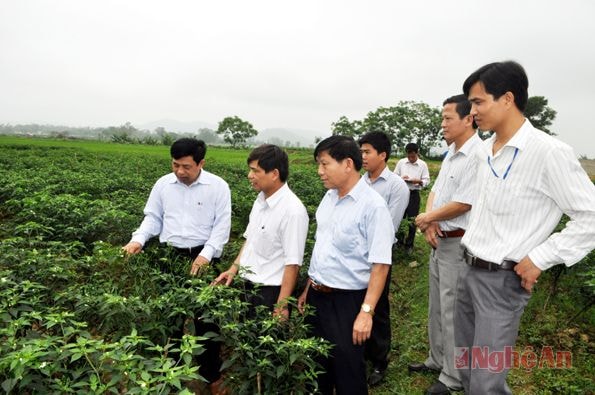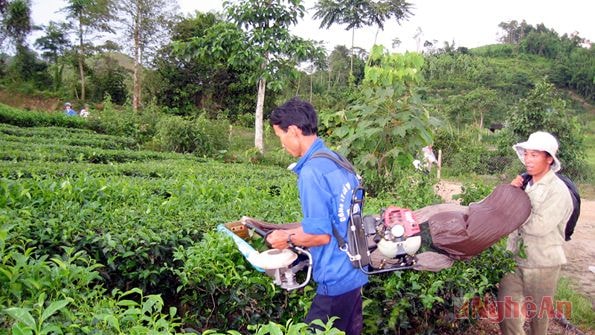Improve competitiveness of agricultural products
(Baonghean) - Commodity agricultural production is an inevitable trend of development requirements to increase income value per unit area. In the trend of increasingly deep integration, especially the formation of the ASEAN common market, it will be a big challenge for Vietnamese agricultural products in general and Nghe An agricultural products in particular.
Potential to be developed
Yen Thanh is an agricultural district, with the main product being rice. In recent years, the district has shifted its focus to introducing high-yield, high-quality varieties that are popular in the market such as BC15, AC5, Bac Thom, and Huong Thom.
Not only producing commercial rice varieties on 3,000 - 4,000 hectares/crop, the district also has joint ventures and partnerships with organizations to produce more than 1,000 hectares of rice varieties of all kinds. Along with the application of science and technology, bringing new quality rice varieties into production, localities and farmers of the district have also proactively entered into joint ventures and partnerships with a number of enterprises to create a production chain according to VietGap standards such as nearly 100 hectares of oranges, mushrooms reaching 500 tons/year.
According to Mr. Nguyen Van Duong, Head of the District Department of Agriculture and Rural Development: "Currently, food production in Yen Thanh not only meets the needs of 290,000 people in the entire district, but also has a surplus of half for goods and livestock farming. The district is actively improving product quality to increase production value..."
 |
| Chairman of the Provincial People's Committee Nguyen Xuan Duong visited the chili pepper growing model for export in Nam Thanh commune. |
Vinh Hoa Company Limited - one of the enterprises that cooperate with farmers to produce commercial rice has cooperated to produce more than 10,000 hectares in Yen Thanh, Do Luong, Hung Nguyen, Dien Chau, Nghi Loc districts... The enterprise contracts with groups, cooperatives, communes, or districts to transfer science and technology, supply seeds, lend fertilizers and consume products for farmers, AC5 rice variety with the brand name "Nghe An rice" is increasingly expanding in area and even the consumption market.
Mr. Phan Van Hoa, Director of the company, said: “Thanks to ensuring production processes, the products made by farmers are all purchased by the enterprise. Thanks to the quality of delicious rice, the AC5 rice brand - "Nghe An rice" not only stands firmly in the domestic market of the province but also reaches out to the two major centers of Hanoi and Ho Chi Minh City”. Mr. Hoa also said that in addition to AC5 rice, the Thao Duoc rice variety with over 2,000 hectares is also asserting its position in the market. However, effective agricultural linkage models like the above can only be counted on the fingers.
In recent years, localities in the province have created many specialized areas for commodities such as peanuts, corn, tea, sugarcane, rubber, cassava, timber trees... contributing to creating raw materials for the processing industry serving consumption and export, bringing in high income. The total export turnover of goods in 2014 of Nghe An reached more than 415 million USD, of which agricultural products accounted for about 50%, especially vegetables, tubers and fruits increased by over 86% compared to 2013.
Along with the above potential and strong crops, Nghe An also has large fruit tree areas with high economic value with a total area of oranges, tangerines, lemons, of which oranges are nearly 5,000 hectares. When entering the main season, Nghe An orange products have dominated the consumer market in the province and spread to many other provinces. Food output in the province reached more than 1.2 million tons/year (2014), in the structure of varieties has gradually shifted to high-quality commodity varieties with about 20%. The livestock industry is also linked with the processing industry to create goods to enhance the product value chain...
The challenges
According to Mr. Nguyen Van Lap, Deputy Director of the Department of Agriculture and Rural Development, although Nghe An's agricultural products are diverse and rich in products, some are still fragmented. For example, rubber products have only about 3,000 - 4,000 hectares put into exploitation; or sugarcane, although there are tens of thousands of hectares, is still not large enough. Besides, the quality of agricultural products of farmers in the area when processed is not high, such as rubber is only in krep form, tea and rice products are at an average level. Or buffalo and cattle with a large herd, but if they are new goods, they only meet the small consumer market in markets and restaurants, but the supply to supermarkets and trading floors has not reached, because buffalo and cow breeds have lower meat quality than other breeds. Even Nghe An's peanuts have good quality but have not done a good job in processing...
From another perspective, Mr. Tran Quoc Thanh, Director of the Department of Science and Technology, said that due to small scale and poor linkage, the application of science and technology in production is not much, affecting the quality of products without high uniformity.
On the other hand, quality control in terms of food safety and hygiene is not good. This makes it difficult to build a brand and even when the brand is built, it is even more difficult to protect the brand because poor quality control can easily be exploited and lost the trust of customers.
Also due to the small scale of production, not applying science and technology to improve quality and reduce costs, the price of Nghe An agricultural products is often high, price competitiveness is weak, so the products are difficult to consume. Meanwhile, in some countries, a farm with a large production scale has created a separate commodity product, ensuring a closed production process from selecting good breeds to planting or raising animals according to a technical process, thereby creating products with uniform quality and when processed into products, the quality is also uniform, building a brand and reputation with customers.
In fact, there are now a number of agricultural products from other countries that have competed with clear advantages over Nghe An agricultural products in the domestic market, such as Thai mangoes, American grapes, Australian beef, etc. On the other hand, Nghe An agricultural products are still mainly produced seasonally, so there are times when they are produced massively, but when needed, they are not available.
 |
| Tea harvest in Thanh Chuong. |
Efforts to enhance value
According to Mr. Ho Ngoc Sy, Director of the Department of Agriculture and Rural Development, Nghe An is still an agricultural province. In the context of increasingly deep integration, especially when ASEAN establishes a common market at the end of this year, besides creating favorable conditions for agricultural products in the province to expand markets in countries in the region, they will also have to face competitive pressure from imported goods from ASEAN countries. If we do not have more drastic solutions and are not careful, Nghe An agricultural products will easily "lose right at home", not to mention "away".
In order for Nghe An agricultural products to be competitive in the commodity and export processing market, first of all, the province needs to pay attention to reviewing and re-evaluating the planning of key products, especially plants and animals with processed products. It is necessary to link production planning with processing planning, avoiding the situation where there are few raw material areas but many factories, thereby causing competition for buying and selling, affecting the supply of products to the market due to lack of input materials in some enterprises and factories, losing the reputation of enterprises and losing the competitiveness of products at certain times.
On the one hand, it is also necessary to re-evaluate the province's agricultural, forestry and fishery processing system for each specific product, including processing capacity, product consumption, especially processing technology, thereby having specific measures to ensure diversification, improve quality and ease of product consumption.
Another important solution is to continue transferring science and technology, applying high technology to agricultural production, in which it is important to ensure that the production stage improves productivity and quality according to international food hygiene and safety standards; thereby increasing the value of products, reducing costs, contributing to increasing the value and efficiency of production.
Along with the above solutions, it is necessary to strongly transform the form of production organization towards joint ventures and associations through enterprises, cooperatives, and cooperative groups, forming large specialized commodity production areas in agriculture, creating agricultural products of uniform quality. Promote the connection of "4 houses", in which the State plays a guiding role so that scientists, enterprises, and farmers follow a common direction.
Farmers must demonstrate responsibility for complying with production processes, especially being loyal to the business. In addition to immediate benefits, it is also necessary to see long-term and sustainable benefits to adapt to the market economy. Producers must build trust with consumers through their own quality products. Quality control includes controlling imported goods, preventing low-quality, low-cost goods from entering through smuggling. Pay attention to building and developing brands for agricultural products. Synchronously implementing the above solutions, with responsible cooperation and efforts from many sides, is an important basis to improve the competitiveness of Nghe An agricultural products, contributing to building a sustainable agricultural development of the province.
Minh Chi






